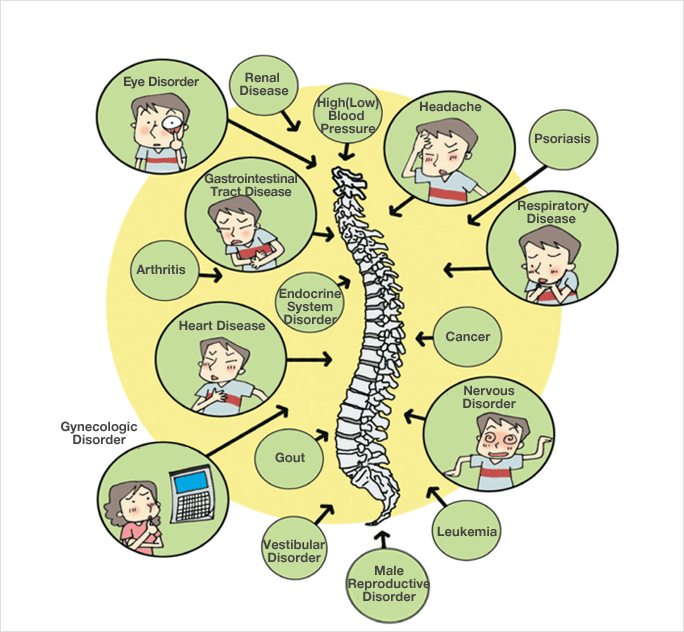Home > R&D > Spine Science







-
The chiropractic is the Greek word that is a made of two words: hand and treatment, indicating a hand treatment. However, nowadays, the word, chiropractic is used to indicate a treatment that adjusts a misaligned spine with hands. The chiropractic was introduced by Dr. David Palmer and was known all over the world in 1895 as one of the leading treatment of the spine. At that time, chiropractic was integrated treatment that included massage therapy, water therapy, light therapy, magnetic treatment, homoeopathy and bone setting. When the intervertebral disks were found, the chiropractic was used in order to adjust misaligned spine that press 31 threads of spinal nerves in the spinal cord. Besides, there are more diseases or illnesses that are resulted from misaligned spine, such as lumbago, tinnitus, autonomic nerve malfunctions and so on. The chiropractic helps the body to be cured naturally. Nowadays, the chiropractic is internationally used as a formal medical practice since
it helps individuals to have an appropriate spinal structure that can enhance organs, accelerate lymph circulation and strengthen the immune system.

The following data are the results of research conducted by the joint effort of International Chiropractic Association affiliated Chiropractic Research Center and the Palmer Chiropractic Research Institute.
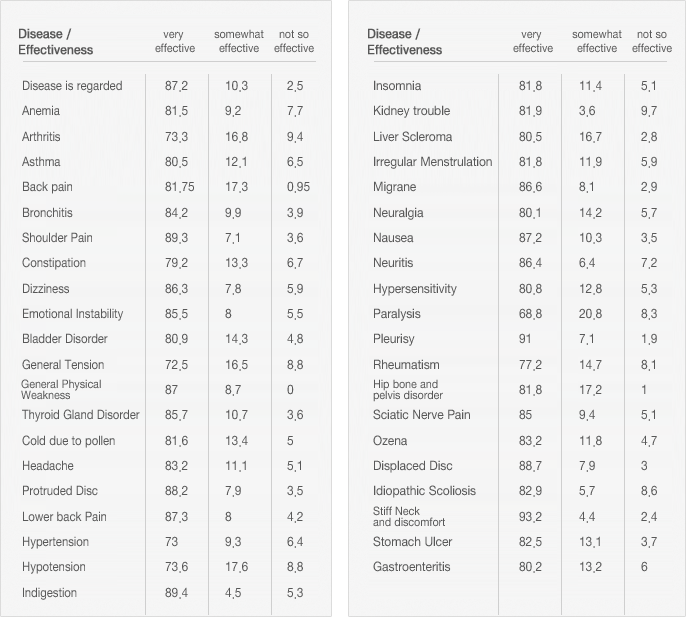


-
Thermotherapy usually uses conduction heat or radiant heat. However, thermotherapy also uses sand, warm bath, paraffin wax, thermal bath and steam bath. The radiant heat method uses the electronic light bath, ultraviolet radiation and high frequency. The principle of thermotherapy is to apply the heat to the body to increase the body temperature and to increase bloodstream. Therefore, thermotherapy improves blood circulation, stimulates the metabolism and reduces
pain and muscle tension. In addition, it improves the condition of arthritis, muscle pain, other chronic inflammation and helps individuals to recover from fatigue.
- Thermotherapy
- ① Improves the capability of tissues.
- ② Prevents solidification of joints.
- ③ Relieves pain.
- ④ Relieves muscle strain.
- ⑤ Increase the blood flow.
- ⑥ Reduces inflammation symptoms and edema.


-
In the old days, when people suffered from pain, they instinctively had touched, rubbed or pressed on sore places. Due to the repetitive processes, they found out the areas where they had to touch in order to relieve the pain. This process developed into finger pressure therapy. Indeed, the finger-pressure therapy is the originated from the eastern medicine. However, it is also uses the fundamental of western massage and chiropractic adjustment.
Then, this method developed into acupuncture and moxibustion that use equipment and devices for better treatment.
- Finger-Pressure Therapy
- ① Circulates the blood and lymph glands, vitalizing the metabolism.
- ② Relaxes muscles, releasing muscle strain.
- ③ Adjust deformed ligaments, muscles and tendon.
- ④ Improves organs, stimulating the acupuncture points.
- ⑤ Controls the central nervous system and autonomic nervous system.
- ⑥ Relieves fatigue, controlling the endocrine disability.
- ⑦ Controls body weight.


-
Moxibustion is a type of thermotherapy that makes use of various types of medicinal herbs. The principle of the moxibustion is to burn fluffs on the acupuncture points. Nowadays, the moxibustion is known as a formal medical practice that improves the body organs.
- The Main Effects of Moxibustion
- ① Activates the cells.
- ② Improves blood circulation.
- ③ Changes the blood constituents.
- ④ Controls the hormone discharges.
- ⑤ Controls the nervous systems.
- ⑥ Controls the functions of internal organs.
- ⑦ Relieves pain.
Even the grandest houses are like those built on sand if pillars are weak. Pillar determines the life of a house. Then what is the pillar of our body? It is our spine. Therefore, if we have spine problems, we start having various problems and we constantly need to fix those problems. So how does the spine actually look and what roles does it play?
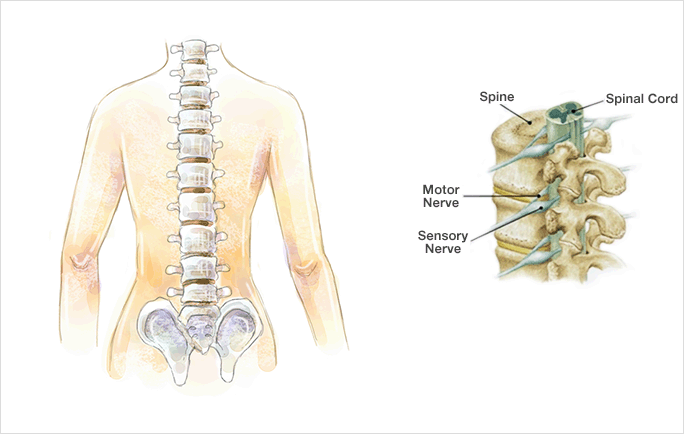

There is a grand house along the seafront. However, if this house is not built of solid column, it cannot be preserved for a long time. In other words, in order to live in a grand house safely, it is important to build a house with solid columns. Then, what is the central column of the body? The central column of the body is the spine. If a person has a misaligned spine, he or she will face many health problems. In order to prevent further diseases, we must know what the appropriate spine structure is and what roles the spine plays in various functions of the body.

The 31 pairs of nerves spread out from the spinal cord are connected to organs, muscles, blood vessels, ligaments and skin tissues. The spinal cords and the spinal nerves also control all senses, movements, postures, body temperature, heart rate, respiration, blood sugar and other functions of the body.

The human had evolved from crawling about on all fours to upright walking over a long period time. Indeed, the structure of the human body and skeleton are very similar to four legged animals. The original shape of the human spine, S structure has helped human to be able to walk upright and to have balance. Therefore, human is not destined to suffer from lumbago, shoulder and arm. All the pains are resulted from various circumstances, such as bad habits, wrong exercises, stress, accidents, genitical problems and so on. Therefore, it is important to have healthy spine for healthy life.



The central nervous system and the peripheral nervous system receive various stimuli from every corner of the body. By responding to these stimuli, they ensure that the body acts properly.
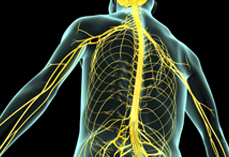
-
For example, when the eyes or ears get stimulated by the lights or sounds, they transmit signals rapidly to the brain and the spinal cord through the peripheral nerves. Then, the central nerve sends signals to muscles and organs to control body functions. The spinal cord passes the information to the brain through the peripheral nerves. Once the brain receives the information, it sends commands to organs. The spinal nerves play significant roles because the brain cannot send signals nor commend to the limbs. Therefore, the brain signals are only sent to the spinal cord rapidly. For these reasons, the nervous system is the lifeline of the body.

The nervous system is divided into the central nervous system and the peripheral nervous system. The central nervous system contains the brain and the spinal cord. The brain is an organ that serves as the center of the nervous system. The spinal cord is a nerve spread out from the brain to the space between the first and second lumbar vertebrae.

The peripheral nervous system is mainly composed of nerves that are connected to the central nervous system to the rest of the body, such as organs, tissues and so on. The peripheral nervous system is divided into the somatic nervous system (subject to the cerebrum’s rule) and the autonomic nervous system (non-subject to the cerebrum realm).

The nerves are spread out from the brain and are branched out to all parts of the body. The nerves spread out from the brain, they are known as the cerebral nerves. In contrast, the nerves spread out from the spinal cord, they are known as the spinal nerves. Usually, there are 12 pairs of cerebral nerves distributed on the face. There are 31 pairs of spinal nerves that are distributed on the body and the limbs.

The autonomic nerve system is distributed to the heart, blood vessels, lung and the digestive system. It is not subject to the rule of cerebrum ; it controls the functions of internal organs by its own accord. The autonomic nervous system is comprised of sympathetic nerve and the parasympathetic nerve. Usually, as shown in the following table, when one side is accelerated, then the other side is restrained. For example, if heart rate is accelerated by the sympathetic nervous system, the parasympathetic nerve slows it down.
Drinking plenty of water is good for your health. Water enhances the blood circulation. Therefore, when there is a lack of water in the body, the blood circulation will be reduced, causing various health problems. Moreover, crooked or misaligned spine badly affects nerves that play significant roles in circulating blood to the related organ. It is important to find out the nature of the relationship between diseases and crooked or misaligned spine.

Most of the blood is produced in the bone marrow found in the spine vertebrae. Therefore, when spine is crooked or misaligned, blood cannot be produced properly and interferences to the spine nervous system can be caused due to the poor blood circulation and the compressed nerves, causing problems of sending signals to the brain that controls the blood circulation.
If we remove the main cause of the poor blood circulation, can the blood circulation be improved?
Unfortunately, we are living in an environment where we simply cannot remove all the hindrances in the way of sustaining good blood circulation. There are many factors that hinder blood circulation, such as pollution, food with chemical additions and so on. Besides, these environments can lead people to have stress and to get sick. As we can see, everybody cannot avoid getting sick. The western medical scientists point out that bacteria, virus and genetics are the main causes of diseases. In contrast, the eastern medical scientists emphasize the fact that the blood circulation is the main of all diseases.The impurities or wastes in the blood affect blood circulation, leading various symptoms. These symptoms can be varied according to the condition of the people. The blister may appear in the womb, myoma, cystitis, frigidity, prostatitis, impotency, chilled limbs, arthritis and back pain. The blood circulations can be only enhanced when all the impurities are removed from the blood.Furthermore, when the liver and the spleen do not remove the toxin and impurities from the blood, people will get sick. Then, what are the major factors that cause the dysfunction of the spleen and the liver?
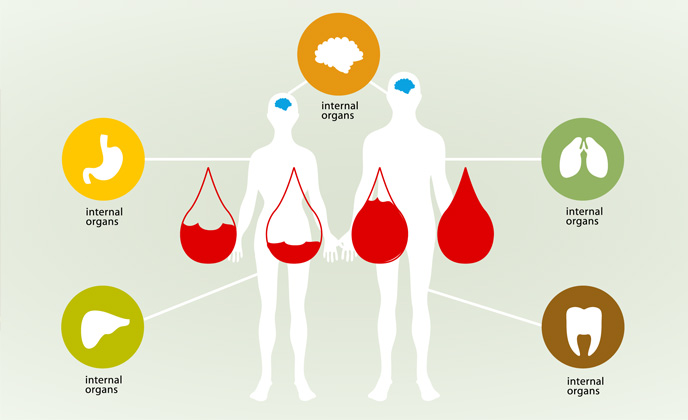

According to the alternative medicine, the liver and the spleen play significant roles in having the blood circulations. However, the western medicine states that the heart and the kidneys control the blood circulation. Indeed, both medicines agree with the fact that these organs are connected to the spinal nerve. The vast majority of the organs is connected to the autonomic nerves from the thoracic vertebrae.From the perspective of the alternative medicine, chiropractic, the 12 vertebrae in the upper back make up what is known as the thoracic vertebrae and these vertebrae are connected to the different organs: T1 to bronchus, T2 to heart, T3 to lung, T4 to gall bladder, T5 to liver, T6 to stomach, T7 to pancreas, T8 to spleen, T9, T10 and T11 to kidneys and T 12 to small intestine. The crooked and misaligned thoracic vertebra will compress nerves, causing dysfunction of organs. For example, if there is a problem with T3, a person will be vulnerable to pleurisy and pneumonia.In accordance with both alternative medicine and western medicine, when T5, T8, T9, T10 and T11 are misaligned or crooked, a person will have poor blood circulation. It also proves that there is the nature of the relationship between the well-aligned spine and the smooth blood circulation. Therefore, in order to have a smooth blood circulation, the spine must be well-aligned and balanced.
The human body is composed of complicated nerve networks that are spread out from the brain to the spinal nerves, peripheral nerves and autonomic nerves. If one of these nervous systems, particularly spinal nerves fails in transmitting signals, it will cause the malfunction of the body because the spinal nerves play significant roles in transmitting signals to the brain and to other nervous system.

The chiropractic emphasizes the fact that spinal nerves are connected to the organs. Other therapies also have mentioned this relationship. The nerves are not only connected to muscles, but they are also connected to organs. Then, how do the spine and organ correspond?Even though every nerve is not connected to internal organs, the vast majority of nerves is connected to the organs, controlling the functions of the body. It is very clear that the spinal nerves are connected to the organs.This does not necessarily mean there is one to one, thread by thread connection between nerves and our internal organs. Therefore, interpretation of such therapy could be different, depending on different perspectives. However, it is very clear that the spinal nerves are interconnected with our body organs.
